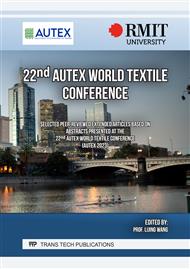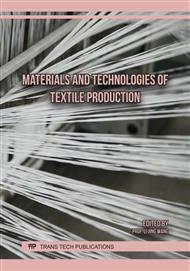[1]
Hearle, J. W., Morton, W. E. (2008). Physical Properties of Textile Fibres. Elsevier.
Google Scholar
[2]
Gupta, V. B. (2002). Heat setting. Journal of Applied Polymer Science, 83(3), 586-609.
Google Scholar
[3]
Bathe, K. J. (2006). Finite Element Procedures. Klaus-Jurgen Bathe.
Google Scholar
[4]
Grujicic, M., Hariharan, A., Pandurangan, B., Yen, C.-F., Cheese40 man, B., Wang, Y., Miao, Y., Zheng, J. (2012). Fiber-level modeling of dynamic strength of Kevlar® KM2 ballistic fabric. Journal of Materials Engineering and Performance, 21, 1107-1119.
DOI: 10.1007/s11665-011-0006-1
Google Scholar
[5]
Ivanov, I., Tabiei, A. (2002). Flexible woven fabric micromechanical material model with fiber reorientation. Mechanics of Advanced Materials and Structures, 9(1), 37-51.
DOI: 10.1080/153764902317224860
Google Scholar
[6]
King, M. J., Jearanaisilawong, P., Socrate, S. (2005). A continuum constitutive model for the mechanical behavior of woven fabrics. International Journal of Solids and Structures, 42(13), 3867-3896.
DOI: 10.1016/j.ijsolstr.2004.10.030
Google Scholar
[7]
Pham, M. Q., Wendt, E., Häntzsche, E., Gereke, T., Cherif, C. (2022). Numerical modeling of the mechanical behavior of textile structures on the meso-scale for forming process simulations of composite 3D preforms. Engineering Reports, 4(7-8), e12348.
DOI: 10.1002/eng2.12348
Google Scholar
[8]
Sakakibara, K., Yokoyama, A. (2007). Numerical simulation of deformation behavior of fabric structures under bi-axial load. Journal of Textile Engineering, 53(2), 79-86.
Google Scholar
[9]
Sockalingam, S., Gillespie Jr, J. W., Keefe, M. (2014). On the transverse compression response of Kevlar KM2 using fiber-level finite element model. International Journal of Solids and Structures, 51(13), 2504-2517.[10] Tan, P., Tong, L., & Steven, G. P. (1997). Modelling for predicting the mechanical properties of textile composites-A review. Composites Part A: Applied Science and Manufacturing, 28(11), 903-922.
DOI: 10.1016/j.ijsolstr.2014.03.020
Google Scholar
[11]
Nilakantan, G., Keefe, M., Bogetti, T. A., Adkinson, R., Gillespie Jr, J. W. (2010). On the finite element analysis of woven fabric impact using multiscale modeling techniques. International Journal of Solids and Structures, 47(17), 2300-2315.
DOI: 10.1016/j.ijsolstr.2010.04.029
Google Scholar
[12]
Peirce, F. T. (1937). 5-The geometry of cloth structure. Journal of the Textile Institute Transactions, 28(3), T45-T96.
DOI: 10.1080/19447023708658809
Google Scholar
[13]
Miyaki, H., Sakuma, A. (2018). Phantom-element Technique for Periodic Deformation Analysis of Plain Fabrics using LS-DYNA. In Proceedings of the ASME 2018 International Mechanical Engineering Congress and Exposition, Vol. 52149, p. V009T12A050.
DOI: 10.1115/imece2018-87459
Google Scholar
[14]
Miyaki, H., Sakuma, A. (2020). Diagram Design of Weaving Process for Touch-Feel Estimation of Plain-Woven Fabrics by Finite Element Method. In ASME International Mechanical Engineering Congress and Exposition, Vol. 84492, p. V02BT02A048. American Society of Mechanical Engineers.
DOI: 10.1115/1.0004358v
Google Scholar
[15]
Zhang, J., Miyaki, H., Sakuma, A. (2019). The elastoplasticity behavior of wire in inhomogeneous woven metal mesh. In COMPLAS XV: Proceedings of the XV International Conference on Computational Plasticity: Fundamentals and Applications, pp.378-384. CIMNE.
Google Scholar
[16]
Geers, Marc. GD, Kouznetsova, V. G., Brekelmans, WAM1402. (2010). Multi-scale computational homogenization: Trends and challenges. Journal of Computational and Applied Mathematics, 234(7), 2175-2182.
DOI: 10.1016/j.cam.2009.08.077
Google Scholar
[17]
Li, S. (2008). Boundary conditions for unit cells from periodic microstructures and their implications. Composites Science and Technology, 68(9), 1962-1974.
DOI: 10.1016/j.compscitech.2007.03.035
Google Scholar
[18]
Yu, W., Tang, T. (2007). Variational asymptotic method for unit cell homogenization of periodically heterogeneous materials. International Journal of Solids and Structures, 44(11-12), 3738- 3755.
DOI: 10.1016/j.ijsolstr.2006.10.020
Google Scholar



